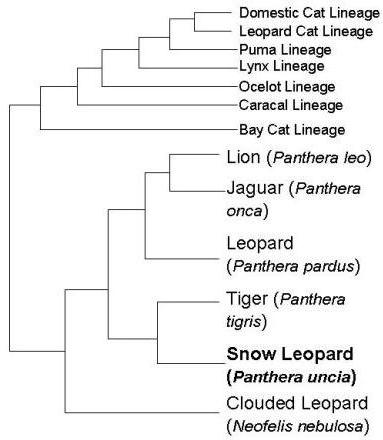Classification
|
Domain: |
Eukaryote |
|
|
Kingdom: |
Animalia |
Multicellular , heterotrophic |
|
Phylum: |
Chordata |
It has a spinal chord |
|
Class: |
It has hair all over it’s body, warm blooded,
feeds it’s offspring with milk from it’s body |
|
|
Order: |
Carnivora |
Meat eater |
|
Family: |
Felidae |
It’s a cat |
|
Genus: |
Panthera |
Molecular studies show similarities |
|
Species: |
Uncia |
Panthera uncia is the scientific name for the
snow leopard |
The phylogenetic tree depicted below is based
on nuclear genes (nDNA) specifically base pairs bp. There has
been and still is much controversy over the genus of the snow
leopard.
 Some scientists believe it should be placed in it's own
genus Uncia making it's scientific name Uncia uncia;
while others maintain that it holds strong similarities to the
genus panthera. The scientists that believe the snow leopards
should be placed in their own genus think this because they
categorize the snow leopard as an intermediate cat linking the
big cats and small cats. Characteristics that make them believe
the snow leopard is not a big cat include their inability to
roar like a big cat can and
Some scientists believe it should be placed in it's own
genus Uncia making it's scientific name Uncia uncia;
while others maintain that it holds strong similarities to the
genus panthera. The scientists that believe the snow leopards
should be placed in their own genus think this because they
categorize the snow leopard as an intermediate cat linking the
big cats and small cats. Characteristics that make them believe
the snow leopard is not a big cat include their inability to
roar like a big cat can and  eating position, typically
eats in a crouched position whereas big cats eat laying down.
However, recent molecular studies have confirmed the snow
leopard as being closer related to the big cats placing it in
the genus Panthera. Click here to view websites of
the snow leopards relative made biology students from spring
2007
the Jaguar,
the lion and a more distantly related cat
the Cheetah.
eating position, typically
eats in a crouched position whereas big cats eat laying down.
However, recent molecular studies have confirmed the snow
leopard as being closer related to the big cats placing it in
the genus Panthera. Click here to view websites of
the snow leopards relative made biology students from spring
2007
the Jaguar,
the lion and a more distantly related cat
the Cheetah.


